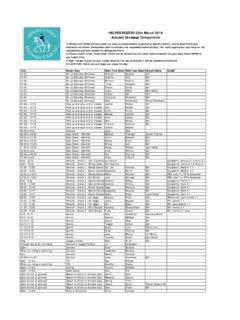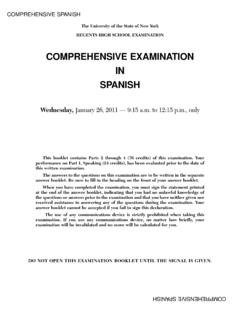Transcription of UPDATED LIGHTING COMPARISON FOR HORSE RIDING …
1 UPDATED LIGHTING COMPARISON FOR HORSE RIDING ARENAS Prepared For Dutch Masters Construction Services Ltd. Barrie, ON. This report compares the LIGHTING efficiency of metal halide fixtures, T-8 fluorescent tube fixtures and induction type LIGHTING fixtures used to illuminate a typical HORSE RIDING arena . January, 2009 Telephone 519 474-4958 Fax: 519-474-4959 Email: LIGHTING COMPARISON FOR HORSE RIDING ARENAS Introduction While natural light is always welcome in all animal facilities, generally some artificial light is required even during the daytime hours to ensure uniform light conditions and reduce shadows.
2 With big buildings like RIDING arenas, a large number of LIGHTING fixtures are required to provide this uniform light. As electrical energy continues to become more expensive, it is important to choose a LIGHTING system that is both effective and cost efficient. Types of LIGHTING Fixtures One of the most common choices for LIGHTING large floor areas with a relatively high ceiling or roof is metal halide fixtures. Newer, more energy efficient T-8 fluorescent tube type fixtures can also be used for this type of application.
3 More recently, induction LIGHTING fixtures are being marketed as a better long term option. All of these lamp types use the principle of gas discharge within the tube or bulb to create visible light. In the case of fluorescent tubes, they are low pressure discharge fixtures whereas the metal halide lamps are high intensity discharge devices with both types having the metal electrodes located within the bulb itself. Induction type light fixtures utilize a remote electronic ballast to generate a high frequency electromagnetic field which can excite the gases contained within the bulb without any electrodes exposed to the gases within the bulb itself.
4 The electrical energy is transmitted or induced by way of a magnetic field. Think of induction LIGHTING as wireless LIGHTING between the ballast and the bulb. In recent years, the conventional fluorescent tube has been improved by both reducing its tube diameter and increasing its efficiency at producing light with less wattage. Rather than using the original T-12 tubes, today s fluorescent fixtures are equipped with T-8 and even T-5 tubes. The 12, 8, and 5 refer to the number of 1/8-inch diameter increments for the tube size.
5 That is, a T-12 tube is inches in diameter whereas a T-5 is only 5/8 of an inch in diameter. At this time, the T-8 fluorescent fixture is the recommended tube size to use in livestock facilities based on its ability to be housed in a vapour tight fixture and not cause any problems with heat build-up, dust and moisture. T-5 lamps are the most energy efficient and allow for more dimming options but are only recommended for clean, dry environments. A typical 8-foot long T-8 light fixture equipped with two, 51 watt tubes will produce 8000 lumens of light for an energy efficiency of 78 lumens per watt when it is new.
6 However, the light output does reduce over the expected 20,000 hour lifetime such that the average lumen output is closer to 7000 which yields an efficiency of about 69 lumens per watt. Note that this number does not include the extra wattage required by the ballast. (in the range of 10 watts). Including the ballast, the average efficiency reduces to around 62 lumens per watt. While metal halide lamps come in several common sizes, the 400 watt, phosphor-coated fixture is most often used in animal facilities with ceilings higher than 12 feet.
7 Again excluding the power required by the ballast (approximately 50 watts), this fixture will consume 400 watts of electrical energy and produce an average of 24,600 lumens of light for an efficiency of 61 lumens per watt. The metal halide lamp does produce more light when new (34000 lumens) and slowly reduces over its 20000 hour rated life such that the average lumens output was used in the calculation. Including the ballast energy, the average efficiency for a metal halide lamp will be about 55 lumens per watt.
8 Induction LIGHTING is now being promoted as a more efficient and much longer lasting type of LIGHTING system. Its best feature is that with the absence of electrodes within the bulb, these fixtures have a rated life of 100,000 hours which is 5 times longer than either fluorescent tubes or metal halide fixtures. Another selling feature is the fact that they provide instantaneous light like fluorescent tubes and unlike metal halide lamps that require several minutes to attain full brightness. To date most induction fixtures are available in the lower wattage output range.
9 A 250-watt induction fixture boasts an initial output of approximately 27,000 lumens. Since most all light fixtures still lose light output over time and good data is not available for these particular lamps, I am recommending an allowance of 25% be made for the average light output over the life of the bulb (75% = 20,250 lumens). Adding in the ballast power of 13 additional watts, the average efficiency calculates to 77 lumens per watt. Looking at a smaller 200-watt induction fixture, it will yield and average of 15,350 lumens for an energy efficiency of 73 lumens per watt.
10 I did come across a 300-watt induction type LIGHTING fixture with and average yield of 24,450 lumens yielding an in-service efficiency of 77 lumens per watt. Initially, it would appear that the induction type fixtures are more efficient at utilizing electrical energy than either the fluorescent tubes or metal halide lamps. But; what about the number of fixtures that will be required in a typical RIDING arena ? Energy COMPARISON for Typical RIDING arena Let s consider a RIDING arena measuring 80-feet wide by 208-feet long with 16-foot high clearance to the ceiling or roof system.







